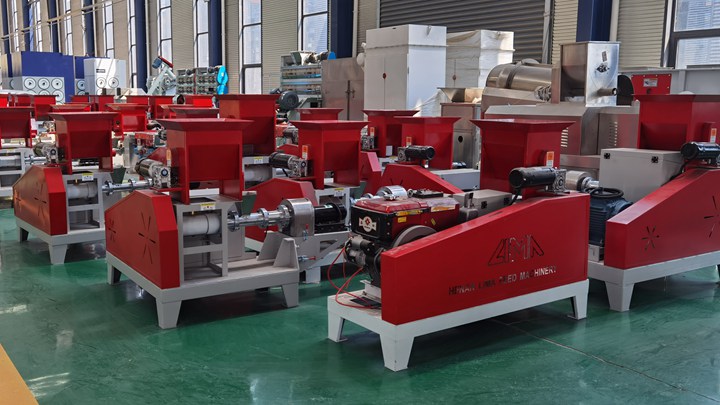.jpg)
The first fish feed pellets were introduced to hatchery trout at the Red River Hatchery near Taos. The pellets resulted in improved conversion rates of food intake to fish production, and lead in turn to the wider adoption of fish pellets in hatcheries.[2] Sustainability. Fish feed production in Stokmarknes Norway. Dry fish feed pellets
.jpg)
This small scale poultry feed production line is designed for manufacturing fodder pellets for various poultry animals (Phasianidae and Anatidae 250,000 ton/year Fish Feed
.jpg)
The 24-28t/h aqua feed mill plants are made up from modules combined with focus on simplicity in operation, energy efficiency, flexibility in processes, high controllability and traceability. Our 24-28t/h aqua floating extruded feed manufacturing solution is future-proof and can be scaled by adding extra modules as your needs for a higher
.jpg)
Extruded Feed: Extruded feeds often have more fat than pelleted feeds to prevent crumbling, offering more calories for hard feeders and high-performance horses. Horses may need days to adjust to extruded feed’s lighter texture. Benefits include less contamination, longer water stability without nutrient loss, higher digestibility, and
.jpg)
The regimes of extruded pellets fish compound feed production with minimal crumbling were defined using a mathematical model. A 3-factorial central composite design was implemented to obtain a
.jpg)
Fish feed pellets can be divided into hard feed pellets, soft feed pellets and extruded feed. The diameter of feed pellets range from 0.5mm to 10mm. And the selection of feed size depends on what kind of aquatic animal to feed. So before searching for a fish feed manufacturing machine, you must decide what size of feed pellets you need.
.jpg)
The annual production capacity of 70,000 tons of expanded fish feed, 110,000 tons of fish feed pellets, and 20,000 tons of special small feeds will be formed, and a total of 200,000 tons of aquatic feed production projects. Large-scale Fish Feed Pellet Production Line and Extruded Line With an Annual Output of 200,000 Tons.
.jpg)
5 days ago · The economics or cost of feed production is dependent on 3 crucial factors: manufacturing cost, cost savings due to formulation, and feed performance. The manufacturing cost is higher for extruded pellets because the cost of acquisition of the equipment is higher than that of pellet mill. Also, the production capacity of the extruder for the
.jpg)
Jul 14, 2023 · A minimal crumbling is provided at the following values of. the factors -. feed mixture moisture before e xtrusion is 32%, extrusion temperatur e is 132 °C, and pressure is. 0.4 MPa. In the
.jpg)
Two types of fish feed making machines can be used for pelletizing fish feed: common fish feed pellet machine and fish feed extruder machines. Small Fish Feed Pellet Machine & Fish Feed Extruder Machine
.jpg)
Sep 6, 2022 · Briefly, fish feed extrusion process requires a fish feed hammer mill to grind raw materials, mixer to blend raw materials including vitamin-mineral premix, the wet type fish food extruder machine with steam preconditioner (yes, steam is equired for quality pellets) and cutter head to shape the pellets, and finally a dryer-cooler to ensure
.jpg)
Mixing: Ground ingredients are mixed together in a feed mixer machine. Conditioning: The mixture is heated and moisturized to prepare for extrusion. Extrusion: This is the core step where the conditioned mix is pushed through a die. Drying: The extruded feed is dried to remove excess moisture. Cooling and Packaging: Finally, the feed is cooled
.jpg)
The production of aquatic feed often uses a horizontal double-shaft paddle high-efficiency feed mixing machine or a double-shaft double-screw mixer. The former has a mixing time of 2 to 3 minutes and a CV of less than 5%; the latter has a mixing time of 5 to 6 minutes and a CV of 5% to 6%. . 4-5T/H floating fish feed plant often uses two mixing

We create complete solutions for producing floating pellets with moderate protein and fat content for feeding warm-water species such as tilapia, eels and catfish. We can help you choose between a single screw and twin screw extruding process to meet your demands and optimize production costs.